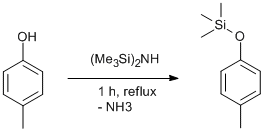Silylation of a phenol with hexamethyldisilazane
SyntheticPage 520
DOI:
Submitted: November 23, 2011, published: November 24, 2011
Authors
Nenad Maraš (nenad.maras@gmail.com)
A contribution from

Chemicals
1,1,1,3,3,3-Hexamethyldisilazane (HMDS)
Procedure
A mixture of para-cresol (22.00 g, 0.20 mol) and hexamethyldisilazane (85 mL, 0.40 mol) was stirred for 1 h under reflux. The reaction mixture was then vacuum distilled from the same flask using a short Vigreux column (10 cm). The fraction distilling at about 120 °C and 80 mbar was collected to give the product as a colorless oil (28.72 g, 80% yield).
Author Comments
The product was completely pure by 1H NMR and the same procedure was equally successful also on phenol. Higher yields should be achievable using a more efficient distillation column.
When searching for the syntheses of this and related phenyl trimethylsilyl ethers in the literature, numerous examples using HMDS with acid catalysts of all sorts can be found (usually in a solvent like dichloromethane or acetonitrile). The use of catalysts and solvents is in most cases unnecessary as the reaction proceeds just fine neat and under reflux conditions (bp of HMDS is 125 °C). I'm sure this is nothing new, but the information might have become obscured, not only due to the flood of catalyzed examples, but possibly also by the difficulty in finding any good catalyst-free example in the literature. Primary alcohols also get silylated with HMDS without a catalyst and a valuable study on the topic of catalyst influence on the silylation of various types of functional groups with HMDS is that of Bruynes and Jurriens. Interestingly, when using nitromethane as a solvent, phenols and alcohols react already at room temperature (Kadam and Kim).
Data
1H NMR (CDCl3, 300 MHz) 0.24 (s, 9H, Si(CH3)3), 2.27 (s, 3H, CH3), 6.73 (AA'XX', J = 8.5 Hz, 2H), 7.02 (AA'XX', J = 8.5 Hz, 2H).
Lead Reference
C. A. Bruynes and T. K. Jurriens, J. Org. Chem. 1982, 47, 3966–3969
Other References
S. T. Kadam and S. S. Kim, Green Chem. 2010, 12, 94–98
Supplementary Information
Keywords
aromatics/arenes, bis(trimethylsilyl)amine, ethers, substitution, TMS